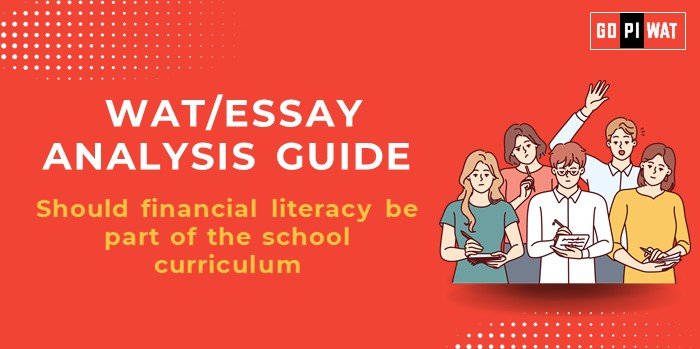📋 Written Ability Test (WAT) Analysis Guide: Should Financial Literacy Be Part of the School Curriculum?
🌟 Understanding the Topic’s Importance
Financial literacy is the foundation for economic empowerment, linking directly to poverty reduction, national productivity, and individual financial well-being. In a fast-growing economy like India, equipping students with financial knowledge can foster a generation better prepared for real-world financial challenges.
🕑 Effective Planning and Writing
- 📝 Time Allocation (30 minutes):
- Planning: 5 minutes
- Writing: 20 minutes
- Reviewing: 5 minutes
- 💡 Preparation Tips: Note statistics on financial literacy, global success stories, and implementation challenges in India.
✍️ Introduction Techniques for Essays
- ⚖️ Contrast Approach:
“India, a global fintech leader, paradoxically grapples with only 27% financial literacy, exposing the urgent need for systemic educational reforms to bridge this knowledge gap.” - 💼 Solution-Based Approach:
“Integrating financial literacy into school curriculums can empower future generations with essential skills for navigating complex financial systems and achieving economic equity.”
🏆 Structuring the Essay Body
✅ Achievements
- 💡 Improved Financial Behavior: Countries like Canada and Australia report increased savings rates and debt management skills among youth exposed to financial literacy in schools.
- 📈 Economic Impact: Financially literate individuals make informed decisions, contributing to national economic stability and lower default rates.
⚠️ Challenges
- 🌐 India’s Dual Challenge: While financial literacy rates are low (27%), basic literacy gaps in rural and underserved areas exacerbate the problem.
- 🏫 Resource Gaps: Limited infrastructure, untrained teachers, and curriculum overload pose barriers to integrating financial education.
- 🌍 Global Comparisons: Countries like Finland emphasize early financial education, but India’s socio-economic diversity requires a localized approach.
🚀 Future Outlook
- 🖥️ Digital Education Solutions: Utilize AI-based platforms and gamified AR/VR tools to make financial literacy engaging and scalable.
- 🤝 Public-Private Partnerships: Collaboration between governments, schools, and fintech companies can ensure widespread access to quality financial education.
🔚 Concluding Effectively
- ⚖️ Balanced Conclusion:
“Introducing financial literacy in schools is critical to fostering economic empowerment, but success hinges on thoughtful curriculum design and equitable implementation across regions.” - 🌍 Global Comparison Conclusion:
“Finland and Singapore showcase the societal benefits of early financial education. India must tailor similar approaches to address its unique challenges while leveraging digital tools for scale.”
📊 Key Achievements and Challenges
- ✅ Achievements:
- Improved financial decision-making and reduced household debt.
- Enhanced economic awareness among students and future professionals.
- ⚠️ Challenges:
- Resource and infrastructure gaps, especially in rural schools.
- Limited awareness and resistance to curriculum changes.
- 🌎 Global Context:
- 🇫🇮 Finland: Early financial education integrated into core subjects fosters strong financial habits.
- 🇦🇺 Australia: National programs ensure financial literacy aligns with economic and career readiness.
🚀 Recommendations for Sustainable Progress
- 🤝 Collaborate with EdTech Firms: Partner with platforms like BYJU’S or FinLearn to provide engaging digital content.
- 👨🏫 Train Educators: Develop government-certified financial literacy modules for teachers to ensure effective delivery.
- 🏫 Introduce Scalable Models: Start with financial literacy as an extracurricular activity before integrating it into the core curriculum.
✍️ Sample Short Essays
⚖️ Balanced Perspective
“Financial literacy is critical for empowering individuals and ensuring national economic stability. However, its integration in schools requires thoughtful planning to overcome infrastructure and awareness challenges.”
🔧 Solution-Oriented
“Introducing financial literacy as part of the school curriculum can prepare students for real-world financial challenges. Leveraging digital tools and innovative teaching methods can ensure successful implementation across diverse regions.”
🌍 Global Comparison
“Countries like Finland and Australia have demonstrated the benefits of early financial education. India can adopt a similar model, tailored to its unique socio-economic landscape, with a strong focus on digital solutions for scalability.”


